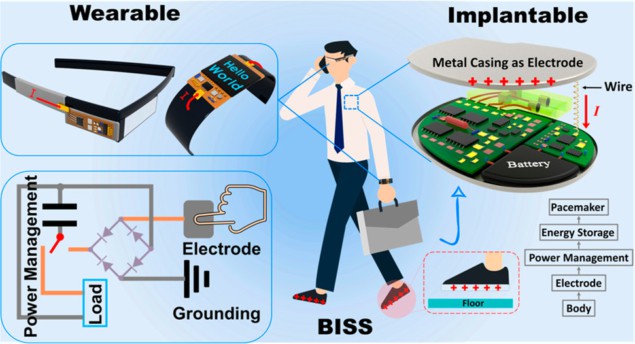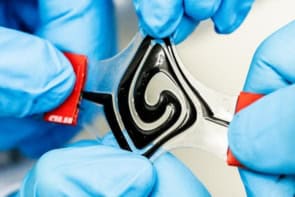
A simple body-integrated self-powered system (BISS) can convert mechanical motions of the human body into electrical energy by exploiting the triboelectric effect. The device works without the need for complicated structures or high-cost production and maintenance thanks to research by a team in China, led by Zhou Li and Zhong Lin Wang at Beijing Institute of Nanoenergy and Nanosystems.
In the paper published in ACS Nano, they show how the BISS can power wearable and implantable devices. Flexibility in the choice of material, size and dimension offers a plethora of possible applications. Among them, the BISS could be integrated into wearable electronic devices, such as smart glasses or wristbands or implanted devices like cardiac pacemakers.
How does it work?
The triboelectric effect, at the base of this system, is a contact electrification mechanism that causes two materials in contact to acquire electric charges upon separation. A common example is a plastic pen that is rubbed on a sleeve: once electrified it picks up small pieces of paper. Triboelectric nanogenerators (TENGs), first invented by Wang, can collect this energy.
In a similar way, movement such as stepping, walking, running and jumping, generates an electric charge between the soles of shoes and the floor. As a consequence, the body acquires electric potential (body electric potential, BEP) that is enough to produce an electric flow if a load is connected between the body and the floor. An electrode attached to the skin can harvest the charge created via BEP. Thus with just the human body and an electrode the BISS can power an electrical appliance from motion.

Maxwell model optimizes motion energy harvesters
In their theoretical model, the human body circuit is simplified as a capacitance and a resistance in series, thus the BEP is inversely proportional to the capacitance of the body. The authors demonstrate how the BISS output depends on the people wearing the device, the type of movement, the characteristic of shoes and environment and the distance between the foot and the floor during the movements. On the contrary, it is not affected by the electrode dimensions.
Human power banks
BISS works both in vitro and in vivo. In the first case, the authors manufacture a wearable prototype, with the electrodes in carbon cloth and in the second case, they verify the activity in vivo, by implanting the electrode in laboratory animals (a rabbit and rats). Furthermore, they test the device with a human that holds the electrode in his mouth (to simulate in vivo conditions), powering up LED bulbs by stepping. In a simplistic way, in the future we may be our own power banks.



